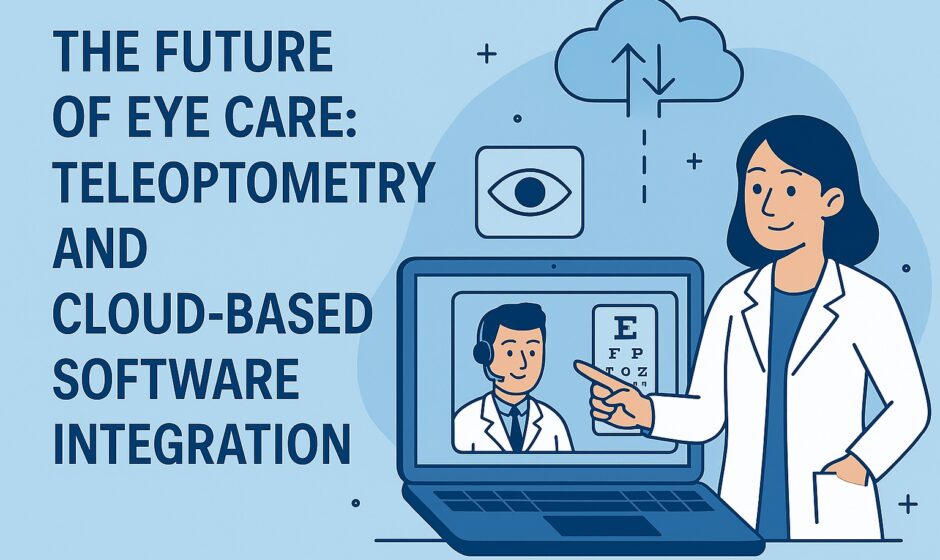The healthcare industry has undergone massive digital transformation over the past decade, and eye care is no exception. With the rise of telehealth and cloud computing, optometry is entering a new era—one where accessibility, efficiency, and data-driven care are reshaping the patient experience. The integration of teleoptometry and cloud-based software is leading this change, offering new ways for providers to deliver care and manage their practices more effectively.
What is Teleoptometry?
Teleoptometry is the remote delivery of eye care services using telecommunication technology. Similar to telemedicine, it enables optometrists to assess, diagnose, treat, and manage patients without requiring in-person visits. Services can include virtual consultations, remote vision screenings, follow-up care, and monitoring of chronic conditions like glaucoma or diabetic retinopathy.
Teleoptometry gained significant traction during the COVID-19 pandemic, when patients and providers were forced to adopt virtual healthcare methods. Since then, the convenience and efficiency of teleoptometry have solidified its role in modern optometric practice.
The Rise of Cloud-Based Software in Optometry
Cloud-based software has emerged as a game-changer in healthcare administration and data management. In optometry, these platforms enable practices to:
-
Store and access electronic health records (EHR) securely from any location
-
Integrate diagnostic tools and imaging systems
-
Automate appointment scheduling and billing
-
Enable real-time collaboration among providers
-
Offer analytics for clinical and business performance
By moving critical data and operations to the cloud, optometrists can improve workflow efficiency, reduce costs, and enhance patient satisfaction.
Bridging the Gap: Teleoptometry Meets Cloud Technology
The real transformation occurs when teleoptometry is combined with cloud-based software. Together, they create a seamless digital ecosystem that improves both care delivery and operational efficiency.
1. Expanded Access to Care
Teleoptometry, supported by cloud platforms, brings eye care to underserved or remote populations. Patients who live far from clinics, have mobility issues, or lack transportation can now receive quality eye care through virtual visits.
Cloud-based EHR systems ensure that patient data is readily available to any authorized provider, no matter where they are. This makes continuity of care possible even when patients are seen by different practitioners or switch between in-person and virtual visits.
2. Real-Time Diagnostics and Monitoring
Advanced diagnostic tools can now be connected to cloud platforms, allowing real-time sharing of retinal images, visual field tests, and intraocular pressure readings. Optometrists can review and analyze this data remotely, providing timely interventions for conditions that require close monitoring.
Some systems even use AI algorithms to assist in screening and early detection of eye diseases. This not only improves accuracy but also speeds up diagnosis.
3. Integrated Patient Portals and Communication
Cloud-based software can include patient portals that streamline communication between patients and providers. These portals allow patients to:
-
Book appointments
-
Receive reminders and follow-ups
-
Access prescriptions and treatment plans
-
Ask questions or upload symptom updates
When integrated with teleoptometry services, these tools enhance patient engagement and empower individuals to take charge of their eye health.
4. Efficient Practice Management
Managing an optometry practice involves more than just patient care—it also includes scheduling, billing, inventory management, and regulatory compliance. Cloud-based solutions automate many of these administrative tasks, reducing the burden on staff and minimizing human error.
These systems can also provide valuable analytics on patient flow, revenue cycles, and treatment outcomes, enabling data-driven decision-making for practice growth.
Challenges and Considerations
Despite its benefits, the integration of teleoptometry and cloud-based software is not without challenges.
Data Security and Privacy
Eye care providers must ensure compliance with HIPAA and other data protection regulations. Cloud platforms must offer robust encryption, access controls, and regular audits to safeguard patient data.
Technological Barriers
Some patients may lack access to high-speed internet or the digital literacy needed to engage in teleoptometry. Practices may need to offer support and alternative options to ensure equity in care.
Regulatory Hurdles
Licensing and telehealth regulations vary by region and can limit the ability of optometrists to provide care across state or national borders. Advocacy for standardized policies is crucial to support broader adoption.
Future Trends in Teleoptometry and Cloud Integration
As technology continues to evolve, several trends are expected to shape the future of optometric care:
1. AI-Enhanced Diagnostics
Artificial intelligence will play a larger role in interpreting diagnostic images, predicting disease progression, and recommending treatments. Cloud-based platforms will serve as the foundation for deploying these tools at scale.
2. Wearable Technology Integration
Wearables that monitor vision and eye health (e.g., smart contact lenses or wearable visual field monitors) will become more common. These devices will feed data into cloud platforms for remote monitoring and early detection of issues.
3. Virtual Reality (VR) and Augmented Reality (AR)
VR and AR technologies can enhance teleoptometry by providing immersive environments for eye exams, vision therapy, or even patient education. These tools will become increasingly integrated into cloud ecosystems.
4. Interdisciplinary Collaboration
Cloud systems allow seamless sharing of data between optometrists, ophthalmologists, primary care physicians, and specialists. This promotes a more holistic approach to managing systemic conditions like diabetes, which have ocular manifestations.
Conclusion
The convergence of teleoptometry and cloud-based software is redefining the future of eye care. These technologies are making eye care more accessible, efficient, and patient-centered than ever before. As digital tools become more sophisticated, optometrists who embrace these innovations will be better positioned to meet the evolving needs of their patients and build resilient, future-proof practices.
However, the transition requires careful planning, ongoing training, and a commitment to data security and equitable care. With the right strategies in place, the integration of teleoptometry and cloud technologies can usher in a new era of smarter, more connected eye care.


